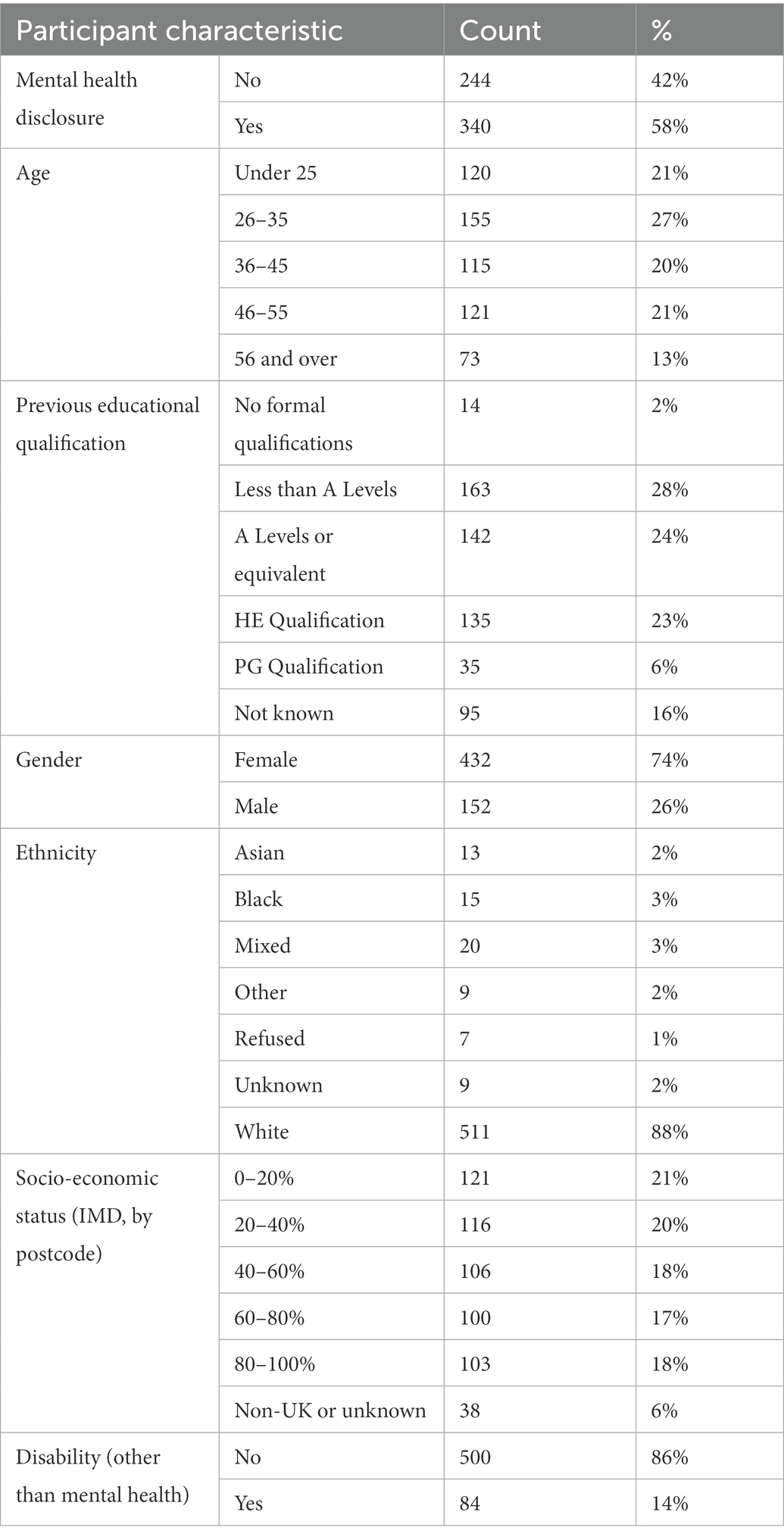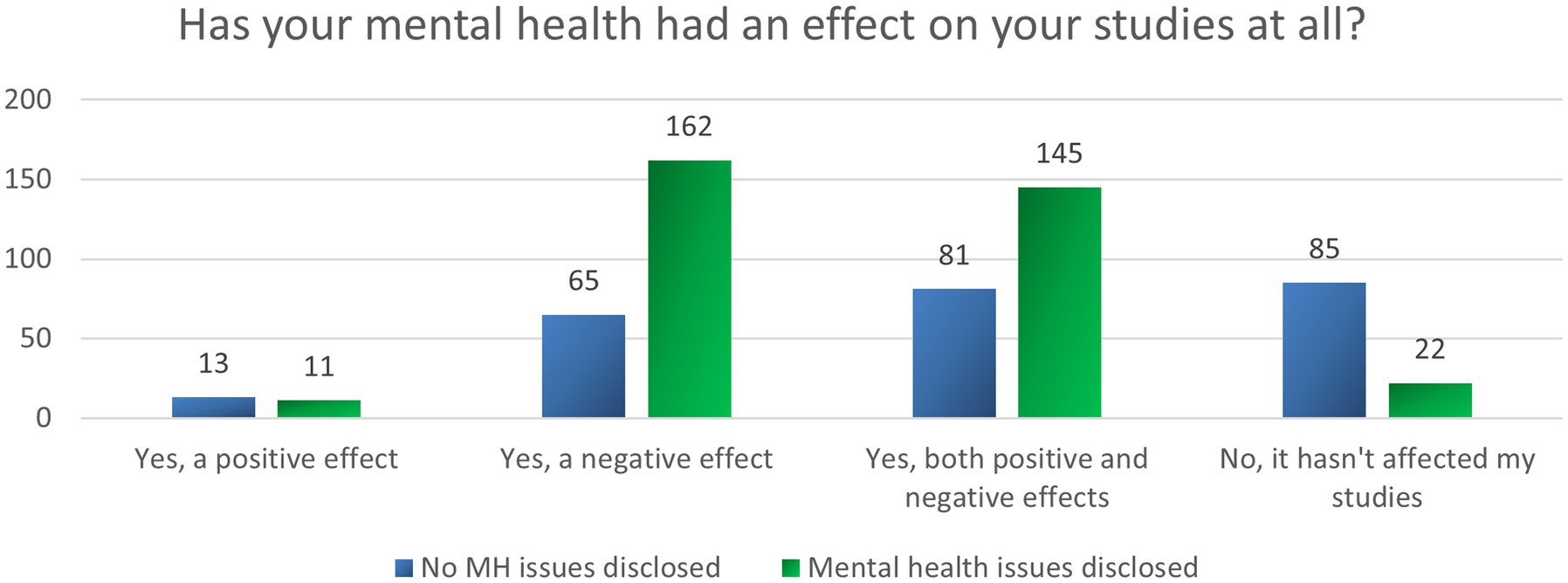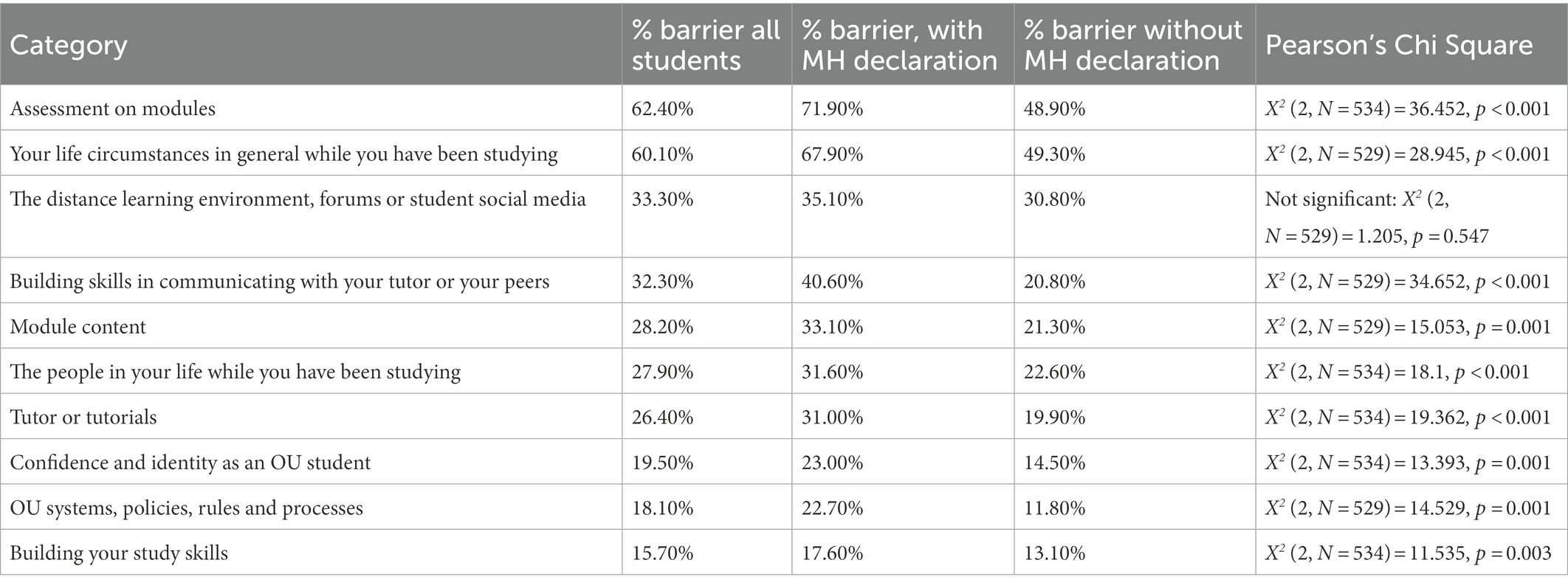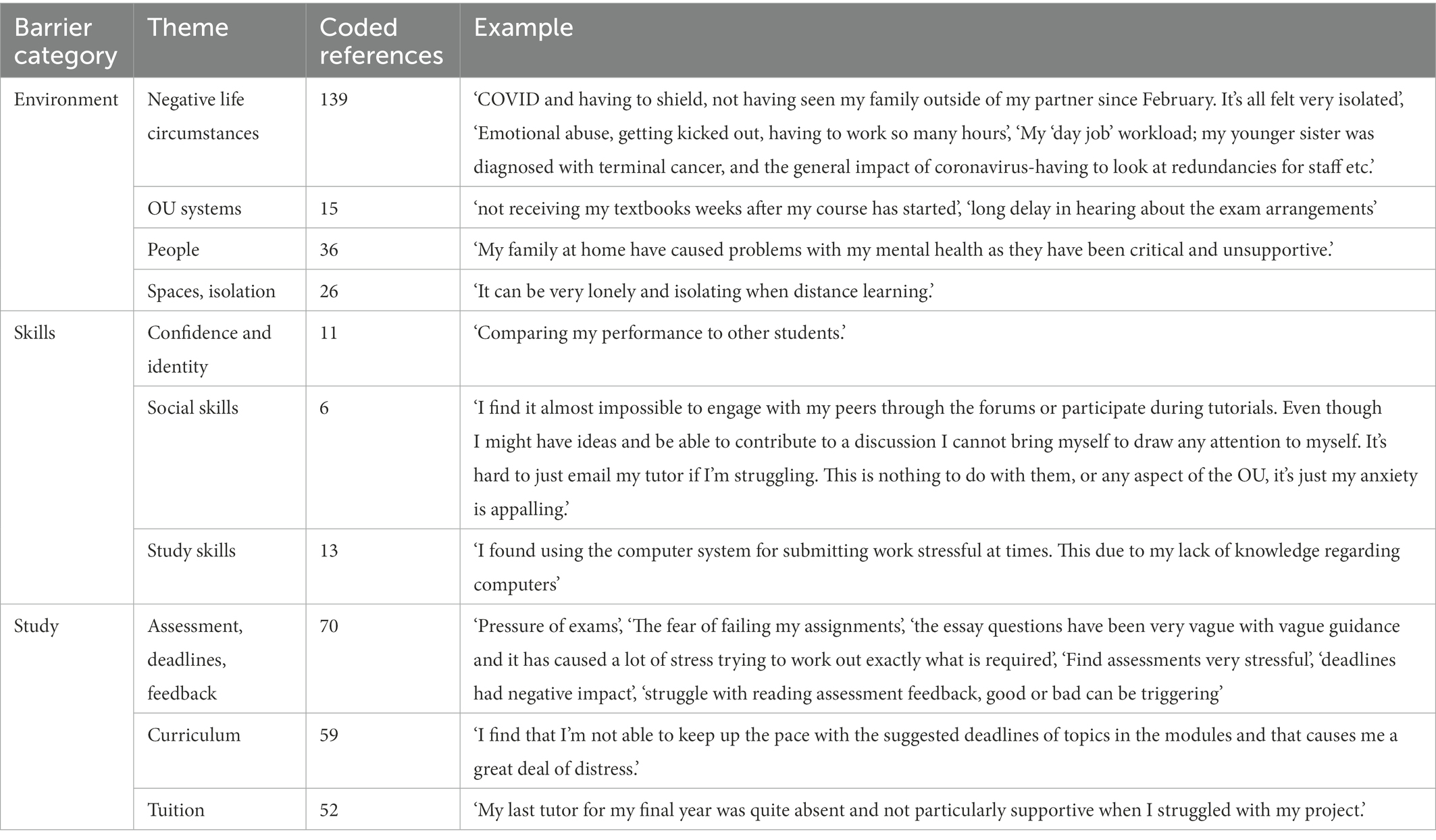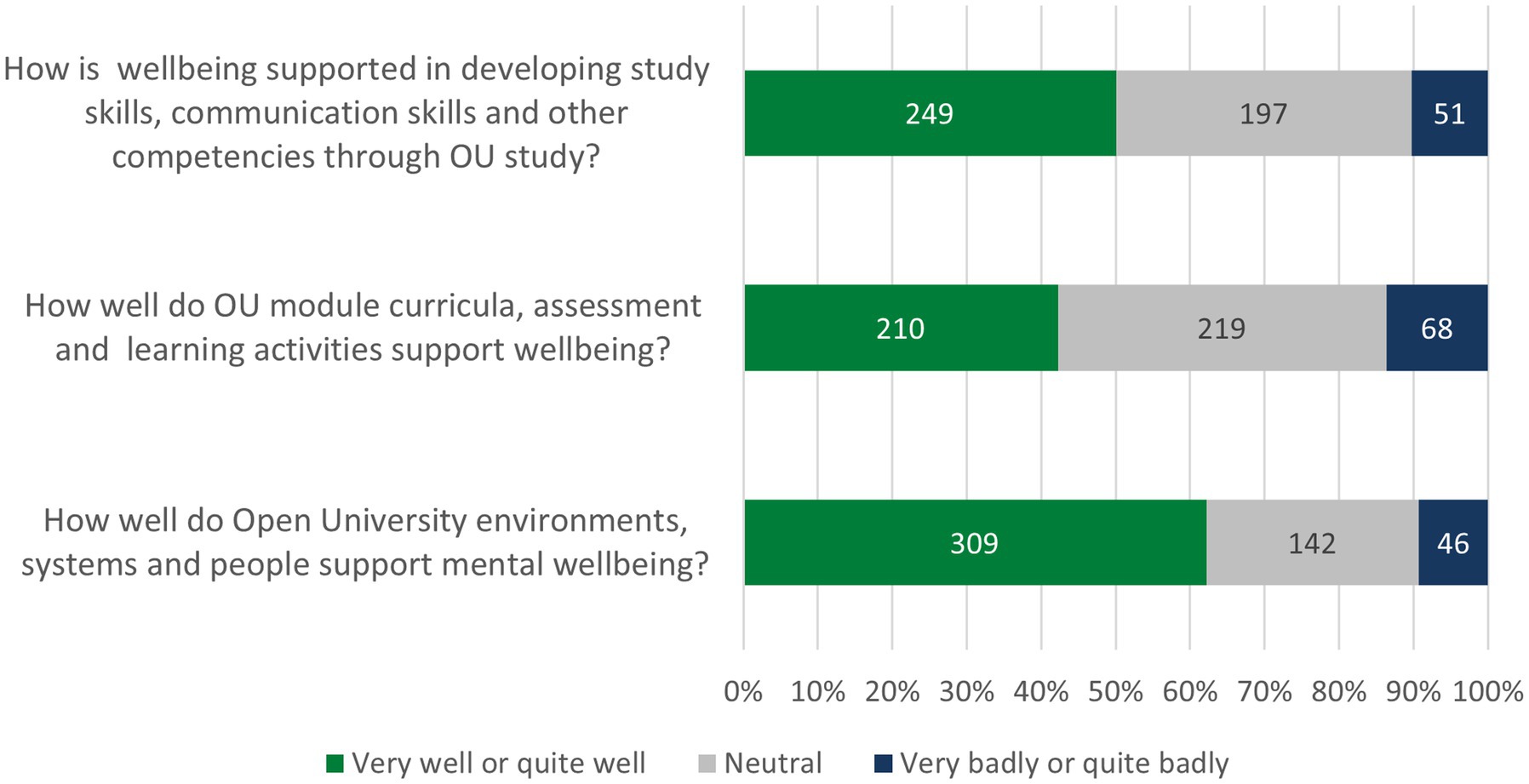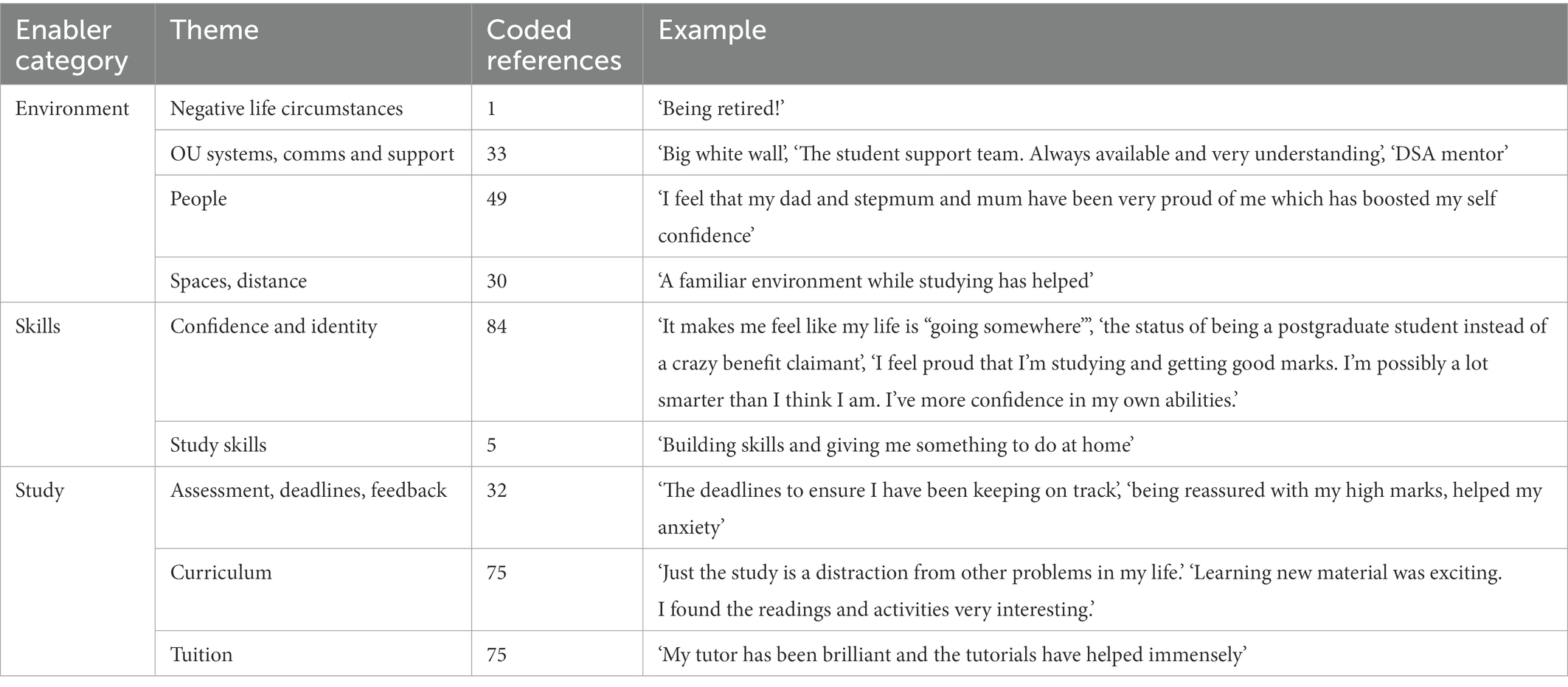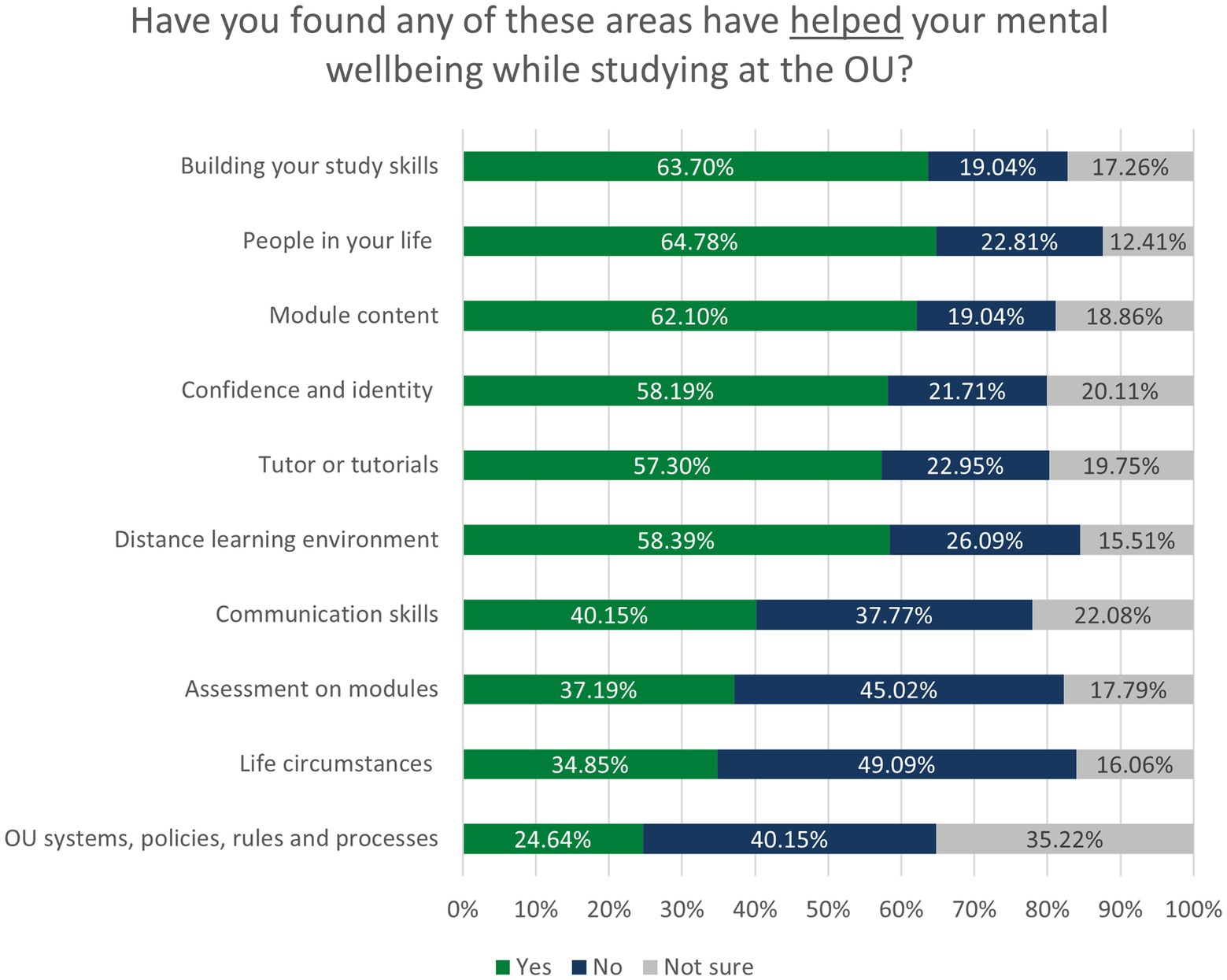- 1Faculty of Learning and Teaching, Arden University, Coventry, United Kingdom
- 2Faculty of Wellbeing, Education and Language Studies, The Open University, Milton Keynes, United Kingdom
- 3Institute of Educational Technology, The Open University, Milton Keynes, United Kingdom
- 4Faculty of STEM, The Open University, Milton Keynes, United Kingdom
Student mental wellbeing is increasingly a priority for universities, and this is particularly critical in a distance learning context. Studies have found that studying, academic pressure, university culture and systems can affect students’ mental health. There are increasing calls for universities to take a compassionate, holistic approach to supporting student wellbeing, and identify the barriers that are created by university cultures, systems, pedagogies, curricula, tuition and assessment practices. This study aimed to identify barriers and enablers to student mental wellbeing in distance learning, and students’ recommendations for changes to be made. Using a student survey (N = 584), we identified that assessment and life circumstances were the most significant barriers, while the greatest enablers were building study skills, the people in students’ lives, and curriculum and module content. The study revealed significant demographic differences in how students experience barriers and enablers, and how likely they feel they are to benefit from solutions. Students with disclosed mental health difficulties were consistently more likely to experience barriers than students without a disclosure, while enablers were experienced by all demographic groups. The study concludes that assessment should be prioritised as an area for action.
1. Introduction
Student mental health and wellbeing is an increasingly high priority for universities (Evans et al., 2018; Hughes and Spanner, 2019). In the United States, it is estimated that a third of students experience mental health difficulties (Lipson et al., 2018), and in Australia, studies have found consistently higher levels of psychological distress, depression and anxiety in students than in the general public (Stallman, 2010; Larcombe et al., 2016). In the United Kingdom, frequent media attention (e.g., Murugesu, 2019; Weale, 2020) and high profile individual cases (BBC News, 2020) have ensured that student wellbeing is of high priority in sector policy and strategy (Hughes and Spanner, 2019; Universities UK, 2020) and is increasingly high on academic research agendas (e.g., Hartrey et al., 2017; Jones et al., 2018; Ribeiro et al., 2018).
This paper reports findings from a study into barriers and enablers to mental health and wellbeing that distance learning students experience in higher education (HE). Distance learning students are often overlooked in literature relating to student wellbeing; this paper shares insight into their experiences, aiming to answer three research questions:
1. What barriers to mental wellbeing do distance learning students experience, and are particular demographic groups more likely to experience these barriers?
2. What enablers to mental wellbeing do distance learning students experience, and are particular demographic groups more likely to experience these enablers?
3. What changes do distance learning students recommend that would enhance mental wellbeing in distance learning?
Terminology relating to mental health is contentious (Davies, 2013; Hughes and Spanner, 2019). In this paper, we follow the approach adopted by UK HE sector bodies; we use the term ‘mental health’ to signify issues that have been medically diagnosed and ‘mental wellbeing’ to cover a broader spectrum of undiagnosed issues such as anxiety and depression. We define ‘barriers’ and ‘enablers’ as determinants within students’ higher education experiences that have a significant positive or negative impact on their overall mental wellbeing.
2. Background and literature
2.1. Mental wellbeing in higher education
Research shows that mental health can have a significant impact on students’ likelihood of success, in terms of their likelihood to complete their studies, their academic attainment and their likelihood to progress (Richardson, 2015; Office for Students, 2019; Lister et al., 2021). Studies suggest that higher education (HE) may have a negative effect on students’ mental health. In the United Kingdom, university students’ mental health is consistently found to be lower than the mental wellbeing of the general population of comparative age (Neves and Hillman, 2019; Office of National Statistics, 2020). Studies have found that studying, academic pressure, university culture and systems may be affecting students’ mental health (Tinklin et al., 2005; Brown, 2016; Ribeiro et al., 2018; Winzer et al., 2018; Lee and Kim, 2019); for example, Tinklin et al. found that higher education ‘systems’ and ‘structural issues’, ‘had exacerbated and even created some of the students’ difficulties’ (Tinklin et al., 2005, p: 510). A dataset analysis of 80,509 students attending college counselling centres in the United States, United Kingdom and Canada confirmed this, finding that ‘academic distress’, including ‘academic performance, pressure to succeed, and postgraduation plans’, was the most unique predictor of anxiety (Jones et al., 2018, p: 253).
Ribeiro et al. found in a systematic review that ‘psychological suffering is inherent in academic life’ (Ribeiro et al., 2018, p: 6). And while a certain level of stress is expected as part of academia, there is a strong case that higher education needs to become more compassionate, and should adapt or update some of the systems, structures and academic practices that cause undue mental health difficulties. Students have called for changes to different areas of academia in order to improve mental wellbeing; these include: ‘Academic teachers and teaching practices; student services and support; environment, culture and communication; course design; program administration; assessment; and student society activities’ (Baik et al., 2019, p: 674).
Assessment is particularly identified in the literature as a potential barrier to wellbeing (Jones et al., 2020). Assessment is heavily value-laden, and practice has been slow to evolve; particularly in summative assessment (Boud and Falchikov, 2007; Hanesworth et al., 2019). Galante et al. talk about levels of ‘psychological distress’ during exams (2018), and Jones et al. identify assessment design, collaborative work, challenges of assessment workload and post-assessment feedback as ‘psychological threats’, both in summative and formative assessment (2020). Baik et al. also found that assessment design impacted on wellbeing, with student perceptions of clarity and fairness in design being particularly critical (2019), while Hill et al. highlight impacts of assessment feedback on student wellbeing (2021). Specific assessment activities, such as groupwork, can be a barrier for wellbeing (McPherson et al., 2019), while impacts of power dynamics involved in faculty-centred as opposed to student-centred pedagogies have been found to affect students’ confidence and wellbeing (Felton and Stickley, 2004; Hill et al., 2019). Feeling ‘overwhelmed’ has been linked to student withdrawal (Weller et al., 2018, p: 43), and, of course, failure and fear of failure are also major contributors to student academic stress or distress (Whittle et al., 2020).
Pedagogy and curriculum are also recognised to contain barriers to wellbeing. For example, Tinklin et al identified ‘Lack of understanding among lecturers’ and ‘badly designed learning experiences’ as barriers (2005, p: 510), and Baik et al found that lack of clarity in teaching materials, low levels of classroom interaction and lack of variety in activities impacted negatively on wellbeing (2019). Specific activities, such as groupwork, can be a barrier for wellbeing (McPherson et al., 2019), while impacts of power dynamics involved in faculty-centred as opposed to student-centred pedagogies have been found to affect students’ confidence and wellbeing (Felton and Stickley, 2004; Hill et al., 2019). Feeling ‘overwhelmed’ by curriculum content has been linked to student withdrawal (Weller et al., 2018, p: 43), and distressing curriculum content has been shown to present particular mental health challenges for some students (Slavin et al., 2014; Bentley, 2017).
Barriers to wellbeing may also be linked with students’ skills and resilience (Houston et al., 2017; Galante et al., 2018; Holdsworth et al., 2018; McAllister et al., 2018). For example, Hewitt and Stubbs identify that difficulties with interpersonal skills, the skills involved in managing workload, and the discipline-specific study skills necessary to achieve good grades, may be a cause of depression, anxiety and stress for students (2017). Similarly, Barrable et al found that stress associated with ‘study skills difficulties’, particularly around ‘time management, staying motivated, and memory techniques’ (2018) were a trigger for mental ill health and negative feelings. Galante et al posit that lack of resilience in dealing with exam stress causes increases in numbers of students seeking counselling support (2018), and Holdsworth et al maintain that students should be taught to develop resilience in higher education in order to deal with ‘constant change and stress’ without negatively affecting their mental health (2018).
In line with broader societal shifts in thinking around mental health (Davies, 2013), there are increasing calls for universities to take a more compassionate, proactive and holistic approach to supporting student wellbeing (Houghton and Anderson, 2017; Hughes and Spanner, 2019; Universities UK, 2020). However, there is a lack of consensus in HE around how best to do this (Hartrey et al., 2017). This has led to a plethora of studies trialling interventions-based approaches such as mindfulness (Galante et al., 2018) or therapy (Viskovich and Pakenham, 2018). These studies generally show only limited or short-term success (Winzer et al., 2018), and have not addressed the underlying issues in university norms and culture. There is a need to take a more social model approach (Oliver, 1983), working in partnership with students (Piper and Emmanuel, 2019; Lister, 2022) and adopting a lens of compassion (Gilbert, 2016), and address the barriers to mental wellbeing within the HE environment, instead of a deficit model focusing only on individuals.
2.2. Mental wellbeing in distance education
The need to address barriers to mental wellbeing applies particularly to distance learning. While literature suggests that part-time adult learning can be beneficial for wellbeing (Field, 2009; Waller et al., 2018), evidence suggests that students in distance learning are more likely to disclose an existing mental health difficulty, may be more likely to need support (Barr, 2014) and that their needs and challenges may be less visible to the university (Coughlan et al., 2021; Coughlan and Lister, 2022). For example, in 2018–19, 9.6% of Open University (OU) students (12,813 in total) disclosed a mental health condition compared to the UK HE average of 2.5% (Advance, 2018). Furthermore, the OU’s Access and Participation Plan identifies a consistent module completion gap since 2013, with the overall percentage of students completing modules around 16 percentage points lower for students with mental health disclosures (The Open University, 2019). This has not been sufficiently addressed in the literature; most studies trialling interventions have focused on a campus environment, and many of the solutions posited translate poorly to a distance learning environment. Studies are needed that apply a critical lens to the cultures, systems, pedagogies, curricula, tuition and assessment practices in distance learning, and identify the barriers these raise for students’ mental health.
In a small qualitative study, Lister et al. interviewed 16 students who had disclosed their mental health condition about their experiences of studying at a distance learning institution (Lister et al., 2021). Lister et al. mapped barriers and enablers to different aspects of students’ higher education experiences, drawing on the ‘capabilities approach’ (Nussbaum, 2000). The capabilities approach recognises the relationships between wellbeing and external capabilities, such as culture and the impact of affordances or obstacles presented by a person’s environment and context (Nussbaum, 2000; Robeyns, 2005). Later interpretations of the capabilities approach also recognise the role of internal capabilities, such as skills building, and identifying ways skills can be formed, developed, used and measured, in order to contribute to broader capability (Heckman and Corbin, 2016). In a higher education context, external capabilities may relate to environment (such as systems, spaces and people) and study-related capabilities (such as curriculum, assessment and pedagogy), which Lister et al. depicted as a taxonomy, shown in Figure 1. This taxonomy illustrates relationships between barriers and diametrically corresponding enablers, and indicates relationships between adjacent themes within both barriers and enablers.
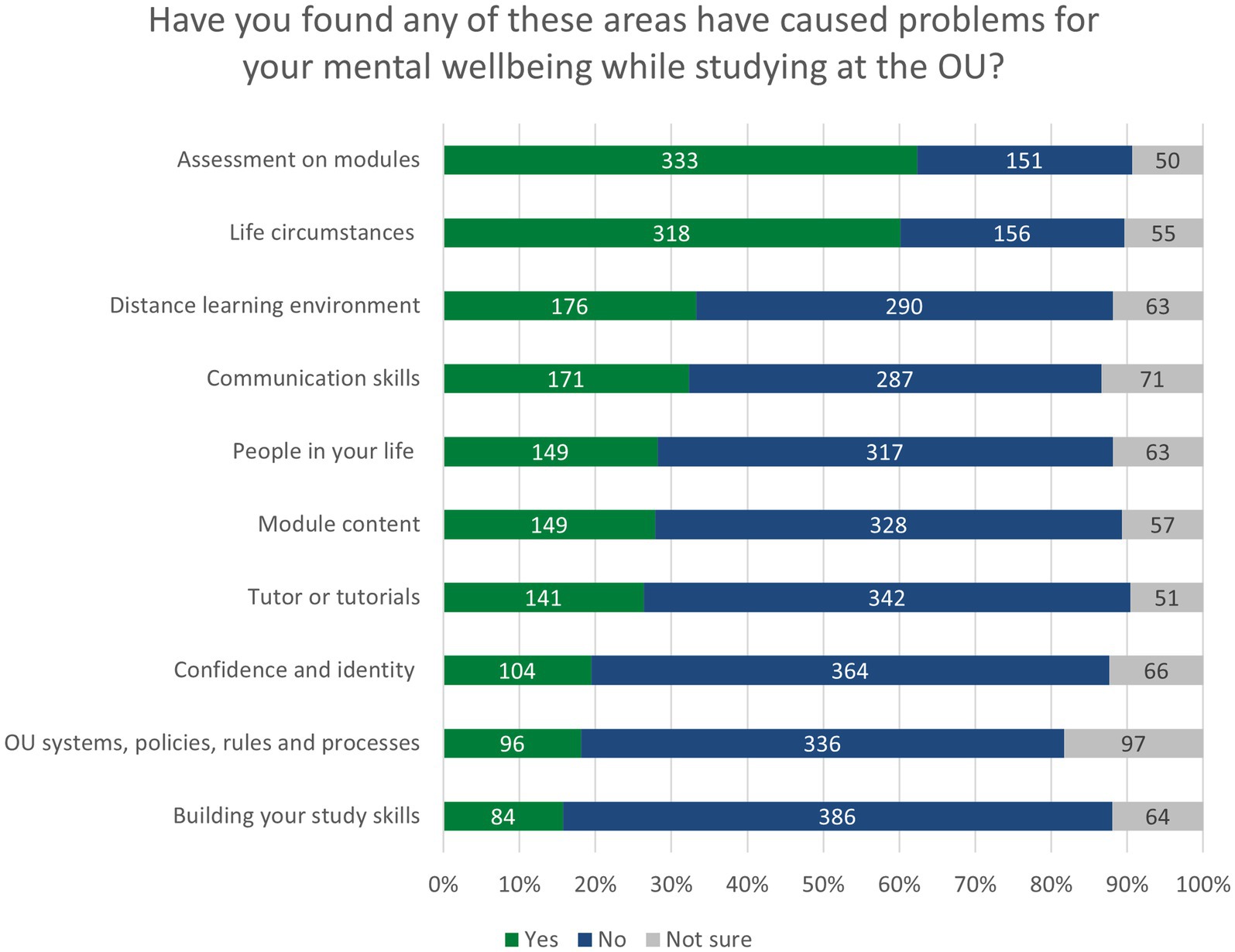
Figure 1. Taxonomy of barriers and enablers to mental wellbeing in distance learning (Lister et al., 2021).
In the study reported in this paper we seek to build on Lister et al’s study by examining the barriers and enablers experienced by a larger sample of distance education students. The study took place in the Open University (OU), a large UK distance learning university with over 140,000 students. At the time of the study (2020–21), 18,498 (12.4% of) OU students disclosed a mental health condition, and recent reporting showed consistent gaps in attainment (1.3 percentage points) and module completion (15.7 percentage points) for students with mental health difficulties (The Open University, 2019). The survey was part of a larger project to identify changes that could be made to better support students’ mental wellbeing in distance learning environments, study and skills-building; this larger project included staff and student focus groups (Lister, 2021), pilot projects and a staff survey (publication to follow).
3. Materials and methods
The project of which this study is part aligns to the critical (or transformative) educational research paradigm, as it seeks not only to understand phenomena but identify ways to redress inequalities inherent within them (Cohen, 2007; Mertens, 2007). It adopts critical pedagogy (Freire, 1970) and the social model of disability (Oliver, 1983) as theoretical frameworks, identifying systemic oppression in educational practice that impacts on student mental wellbeing, and positioning these as barriers to equity that educators have a responsibility to address. In line with this, it holds to the ideology, principles and methods of participatory inquiry (Heron and Reason, 2016), recognising students’ lived experience as expertise.
This paper explores on aspect of the wider project; a survey that aimed to gather data from students on barriers and enablers they had experienced in distance learning, and seek their ideas for changes that could be made. The study and survey instrument were approved by the OU Human Research Ethics committee, Student Research Project Panel, and Data Protection team. The survey instrument is available as supplementary material.
The survey instrument was collaboratively designed with three students who had disclosed mental health conditions, following a participatory design approach. Students worked from a first draft of the instrument, and suggested wording for questions, multiple choice options and refined the question order. An iterative approach was followed, with students collaborating on four drafts before the survey instrument was finalised.
As part of the ethical design, the survey wording and question order were designed to avoid causing distress to participants. The survey opened and closed with general, light-touch questions, aiming to provide a positive onboarding and offboarding experience (e.g., ‘Has your mental health had an effect on your OU studies at all?’ and ‘On the whole, do you find OU study to be good or bad for your mental wellbeing?’) After the onboarding questions, section two of the survey focused on positive effects that study had had on mental wellbeing, encouraging the critical consciousness about the positive role study could play on mental health (i.e., ‘Have you found any of these areas have helped your mental wellbeing while studying at the OU?’ followed by a list of aspects of study with yes/no/not sure options, and a free text question.) The opening text for section two advised students that section three would be asking about negative impacts of study on mental wellbeing, so students were forewarned this would be coming (this included the question ‘Have you found any of these areas have caused problems for your mental wellbeing while studying at the OU’, followed by a list of aspects of study with yes/no/not sure options, and free text question.) Immediately after this, section four focused on support and guidance that was available to students, encouraging them to reflect on what had had a positive impact on them and aiming to raise awareness of any support of which students may not have been aware. The text introducing this section advised that links to all the guidance and support could be found at the end of the survey, aiming to provide practical support to students, while balancing this against the risk of distracting students from completing the survey. The following section asked students’ opinions of specific OU wellbeing initiatives, and the final section asked about broader impacts of distance learning on mental wellbeing, (e.g., ‘In general, how well do you feel your mental wellbeing has been supported by OU module curricula, assessment and the learning activities you take part in?’) aiming to provide distraction and a sense of perspective for any students who may have found it distressing to reflect on negative mental health experiences.
Care was taken to support students; they were advised in the open comment sections that the anonymous nature of the survey meant staff would not be able to respond to any queries raised in the open comment questions, but they were given links to mental health support pages in the question text in case they needed assistance. The survey closed by thanking the students, providing links to the different support options mentioned previously, and wishing students positive mental health and success in their studies.
The survey was piloted with 12 students (eight female, four male) in order to check the validity, particularly in terms of checking that the language was understandable, the questions were framed correctly and that there were no omissions in questions or multiple choice options (Johanson and Brooks, 2010).
3.1. Participants
This study sought to gain insight from students both with and without disclosed mental health conditions, using a stratified, random sampling technique. Two stratified random samples were obtained from the University Surveys team; these comprised a total of 5,000 students studying during academic years 2019/20 and 2020/21. The first sample consisted of 2,500 students who had disclosed a mental health condition to the university; the second sample consisted of 2,500 students who had not disclosed any mental health conditions. The samples were stratified to be representative of the broader cohort in terms of gender, ethnicity, faculty and geographic location, with under 1.4% variance.
In total, 584 students responded to the survey, a response rate of 11.68%. The response rate was higher for students disclosing a mental health difficulty; of the 2,500 students who were invited, 340 responded, resulting in a 13.6% response rate from this group compared to a 9.76% (N = 244) response rate from the 2,500 students who did not disclose a mental health condition.
Participant demographics are shown in Table 1, below. Due to small numbers, some of the classifications were later grouped for analysis (i.e., in ‘previous educational qualification,’ the ‘no formal qualification’ group was combined with ‘less than A-levels.’) Socio-economic status was measured using the UK index of multiple deprivation (IMD) which classifies participants’ relative deprivation according to postcode area.
3.2. Analysis
The survey analysis followed a participatory approach, with students forming part of the analysis team and leading on aspects of the analysis. The survey captured frequency data and open comments, and was analysed using SPSS and NVivo. Frequency data was analysed using descriptive statistics to identify barriers, enablers and impacts. Crosstab analysis of frequency data was used to contrast the findings from different demographic groups, between students disclosing and not disclosing a mental health condition, and students at different stages of study. Pearson’s Chi squared was used to determine statistical significance, with an alpha level of 0.05 for all statistical tests. Open comments in the survey were analysed in NVivo using Thematic Analysis (Braun and Clarke, 2006).
4. Results
This section reports the findings of the survey. First, it reports impacts of students’ mental health on their studies, followed by barriers and enablers to mental wellbeing they experienced and the impact that distance learning had on them. Finally, it reports their suggestions for, and prioritisation of, changes to make distance learning more conducive to mental wellbeing.
4.1. Mental health in distance learning
As shown in Figure 2, 87.7% (N = 477) of students stated that their mental health had had an impact on their studies; only 4.1% (N = 24) reported a positive effect, while 38.9% (N = 227) reported a negative effect and 38.7% (N = 226) reported that their mental health had had both positive and negative effects on their studies. Students disclosing a mental condition reported significantly more negative and mixed effects, while fewer reported positive or no effects on their studies [X2 (3, N = 584) = 83.304, p < 0.001].
4.2. Barriers
In the small-scale qualitative study reported by Lister et al. (2021), 10 barriers to mental wellbeing were identified relating to Study, Skills and Environment (see Figure 1). The results from our survey indicate that respondents experienced the same barriers. Certain barriers were experienced by higher numbers of students; 62.4% (N = 333) of students found ‘assessment, deadlines or feedback’ had caused problems for their mental wellbeing, and 60.1% (N = 318) of students stated that their life circumstances while studying had been a barrier for them. In contrast to this, only 18.1% (N = 96) of students found that ‘OU systems, policies, rules and processes; had been a barrier for them, and only 15.7% (N = 84) found that building their study skills had been a barrier. The results across all 10 areas are shown in Figure 3.
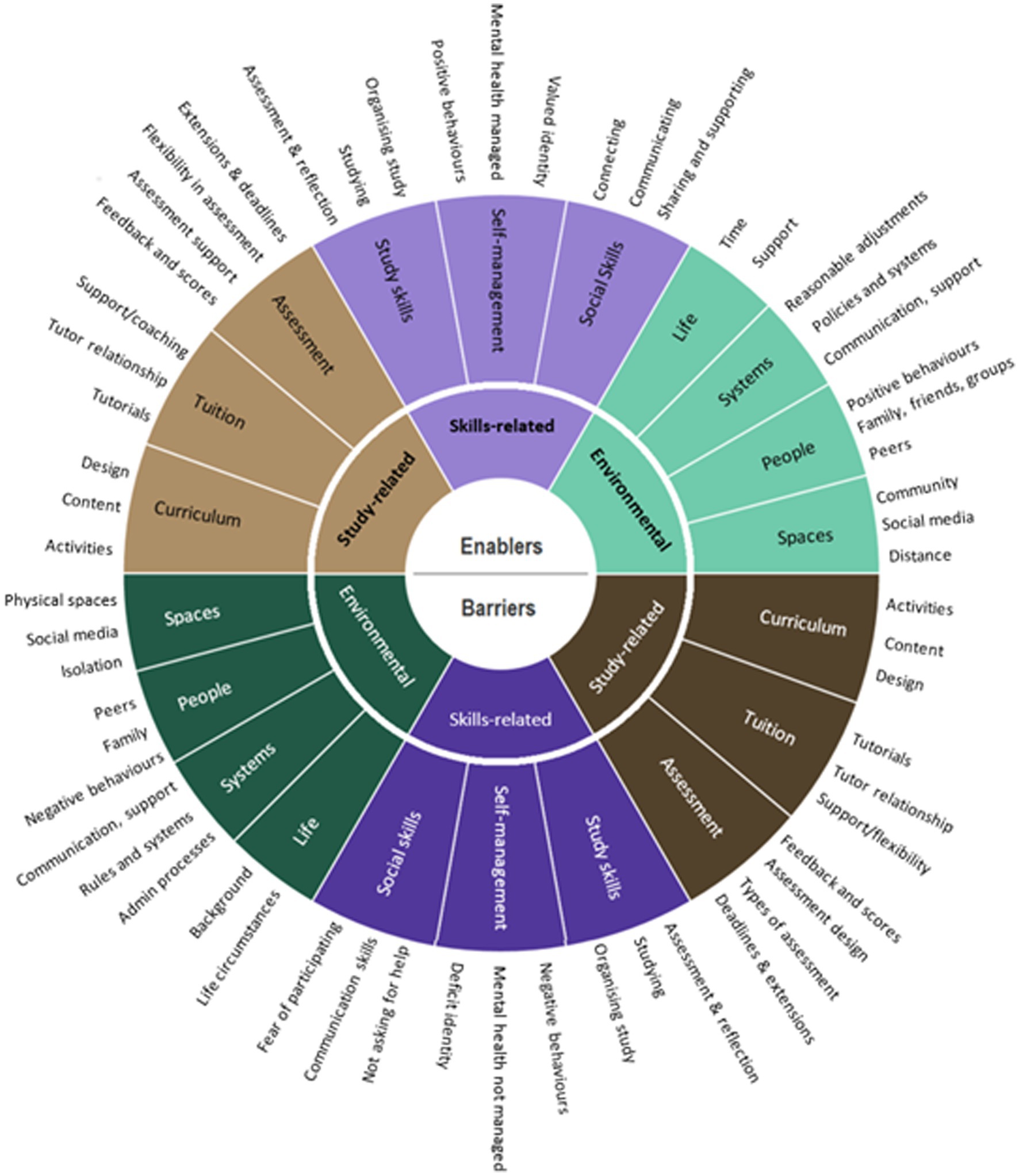
Figure 3. Taxonomy of barriers and enablers to mental wellbeing in study. Figure copyright: Kate Lister, Jane Seale & Chris Douce (CC-BY 4.0).
The responses were analysed for statistically significant variations according to the following criteria:
• Socio-economic status
• Gender
• Ethnicity
• Age
• Mental health disclosure
• Other disability (excluding a mental health disclosure)
• Previous educational qualifications
There were statistically significant differences in nine of 10 areas for students who disclosed a mental health condition. In every area except ‘the distance learning environment,’ students with a disclosed a mental health condition were more likely to experience a barrier than students without a mental health disclosure. These are shown in Table 2, below.
Four of the barriers were also statistically significant for certain students depending on their age, gender, socio-economic status or whether they disclosed a disability.
‘Building communication skills’ was more likely to be a barrier for:
• Women: 34.4% of women compared to 26.1% of men recorded this as a barrier [X2 (2, N = 529) = 8.573, p = 0.014].
• Students with low socio-economic status: 41.7% of low SES students recorded this as a barrier, compared to 33.2% of mid-level SES and 25.8% of high SES [X2 (6, N = 529) = 15.350, p = 0.018].
• Students between 26 and 45 years old: 37.9% recorded this as a barrier, compared to 34.3% of students under 25 and 23.9% of students over 46 [X2 (4, N = 529) = 9.623, p = 0.047].
‘Assessment’ was more likely to be a barrier for:
• Younger students: 77.9% of students under 25 years old recorded this as a barrier, compared to 68.9% of students 26–45 years old and 45.2% of students over 46 [X2 (4, N = 534) = 39.224, p < 0.001].
• Students with a disability other than mental health: 60.1% recorded this as a barrier, compared to 49.9% who disclosed no disability or only mental health [X2 (2, N = 534) = 6.405, p = 0.041].
‘Module content’ was more likely to be a barrier for students disclosing a disability other than mental health, with 37.5% (N = 30) stating it was a barrier, compared to 26.2% (N = 119) without a disability or disclosing mental health issues alone [X2 (2, N = 534) = 7.726, p = 0.021].
‘Life circumstances’ were more likely to be a barrier for younger students, with 74.5% (N = 76) of students under 25 recording this as a barrier, compared 62.6% of students 26–45 (N = 152) and 48.9% (N = 90) of students over 46 [X2 (4, N = 529) = 22.393, p < 0.001].
Students also provided free text responses about ‘anything that had a negative impact on your mental health while studying at the OU.’ This resulted in 301 comments, which were analysed in NVivo and led to 427 coded references. Numbers and examples of coded references per theme are shown in Table 3.
4.3. Enablers
In the small-scale qualitative study reported by Lister et al. (2021), 10 enablers to mental wellbeing were identified, relating to Study, Skills and Environment (see Figure 1). The results from our larger survey indicate that respondents experienced the same enablers. The numbers and percentages of students reporting positive impacts or enablers were generally higher than those reporting barriers. As with barriers, certain enablers were experienced by higher numbers of students; 63.7% (N = 358) of students found that building their study skills had supported their mental wellbeing, and 64.8% (N = 355) of students stated that the people in their lives has been a positive factor. In contrast to this, only 34.9% (N = 191) of students found that life circumstances had been an enabler for them, and only 24.6% (N = 135) found that ‘OU systems, policies, rules and processes’ had played a positive role. The results across all 10 areas are shown in Figure 4.
An interesting finding, in stark contrast to the barriers, was that having disclosed a mental health declaration did not make a statistically significant difference to students’ experience of enablers. The only area where students with mental health responded significantly differently was in assessment, as students disclosing a mental health condition were less likely to experience assessment as an enabler: 48.9% (N = 160) of students with mental health conditions declared it was not an enabler, compared to 39.6% (N = 93) of students without a disclosure [X2 (2, N = 562) = 10.857, p = 0.004]. This implies that enablers are positively experienced in general by students, while barriers appear more keenly felt by students with diagnosed mental health difficulties.
In contrast to this, participants’ age, socio-economic status, gender, and ethnicity had a more significant impact on the responses than a mental health disclosure. Age was significant in five of the 10 areas, with younger students less likely to experience enablers (shown in Table 4.)
Socio-economic status was a significant factor in two areas, with students with lower socio-economic status (i.e., in the bottom 20% of the IMD) less likely to experience enablers in:
• module content: 53.4% of low SES students rated this as an enabler, compared to 64.0% mid-SES and 62.0% high SES [X2 (6, N = 562) = 13.787, p = 0.032].
• life circumstances: 28.1% of low SES students rated this as an enabler, compared to 32.0% mid-SES and 45.9% high SES [X2 (6, N = 548) = 16.402, p = 0.012].
Gender was a significant factor in one area, building study skills. 65% of women found building and developing their study skills an enabler compared to 59.9% of men, and 27.5% of men said it was not an enabler for them compared to 16.2% of women [X2 (2, N = 562) = 9.838, p = 0.007].
Ethnicity was significant in one area: assessment. Black and minority ethnic students were less likely to find assessment an enabler with only 30.4% stating this compared to 38.3% of white students [X2 (4, N = 562) = 11.947, p = 0.018].
Students also provided free text about ‘anything that helped your mental health while studying at the OU.’ The 321 comments received were analysed in NVivo, resulting in 384 coded references that broadly corresponded with the taxonomy and the 10 themes in the survey. The numbers and examples of coded references per theme are shown in Table 5.
4.4. Impact of study on wellbeing
Overall, 71% of students (N = 353) stated that study had an overall positive impact on their mental health, implying that the impact of enablers outweighed that of the barriers. This was felt across all demographics; the only one showing slight significant difference was age [X2 (4, N = 497) = 10.530, p = 0.032]. Students in the ‘under 25’ and ‘26–45’ age brackets were slightly more likely to say that study was neutral or bad for their mental wellbeing, but were still in the minority; 64.2% (N = 61) of students under 25 and 67.2% (N = 154) of students between 26 and 45 states OU study was good for their mental wellbeing.
This was similar when looking at specific groups of barriers and enablers. For example, when asked about skills-related barriers/enablers, 50.1% (N = 249) of students felt that their mental wellbeing had been well or very well supported as they developed study skills, communication skills and other competencies through study, and 39.6% (N = 197) were neutral. There were no significant differences within demographics.
In relation to study-related barriers/enablers, 42% (N = 210) of students stated their wellbeing had been well or very well supported by module curricula, assessment and the learning activities, and 44.1% (N = 219) were neutral. However, students disclosing a mental health condition were slightly less likely to state this, with 41.3% (N = 121) saying ‘well’ or ‘very well’ and also 41.3% (N = 121) being neutral [X2 (2, N = 497) = 8.631, p = 0.013]. This may relate to the strong differences around experiences of assessment for students with mental health issues.
Finally, in relation to environmental barriers/enablers, 62.2% (N = 309) of students stated their wellbeing had been well or very well supported by OU environments, systems and people; 28.6% (N = 142) saying they were neutral and 9.3% (N = 46) saying it has been badly supported in this area. Interestingly, students disclosing a mental health condition were more polarised in this area, with 67.2% (N = 182) saying ‘well’ or ‘very well’ and 11.6% (N = 34) saying ‘badly’ or ‘very badly’ [X2 (2, N = 497) = 20.918, p < 0.001].
4.5. Suggestions for changes
Students were asked an open question about ‘things you would like the OU to do to support students’ mental wellbeing in studying.’ 162 students (28%) gave a response to this question. These were coded in NVivo and clustered into themes, using Braun and Clarke’s Thematic Analysis as a methodology (Braun and Clarke, 2006). These free text responses resulted in 264 references coded to 77 different codes, clustered into 12 themes under five overarching categories:
• Study-related changes (N = 87)
• Environmental changes (N = 95)
• Changes or improvements to support (N = 61)
• Skills-related changes (N = 1)
• No changes suggested (N = 20).
Figure 5 shows a visualisation of themes within these categories, and selected examples are explored in more detail in the following section.
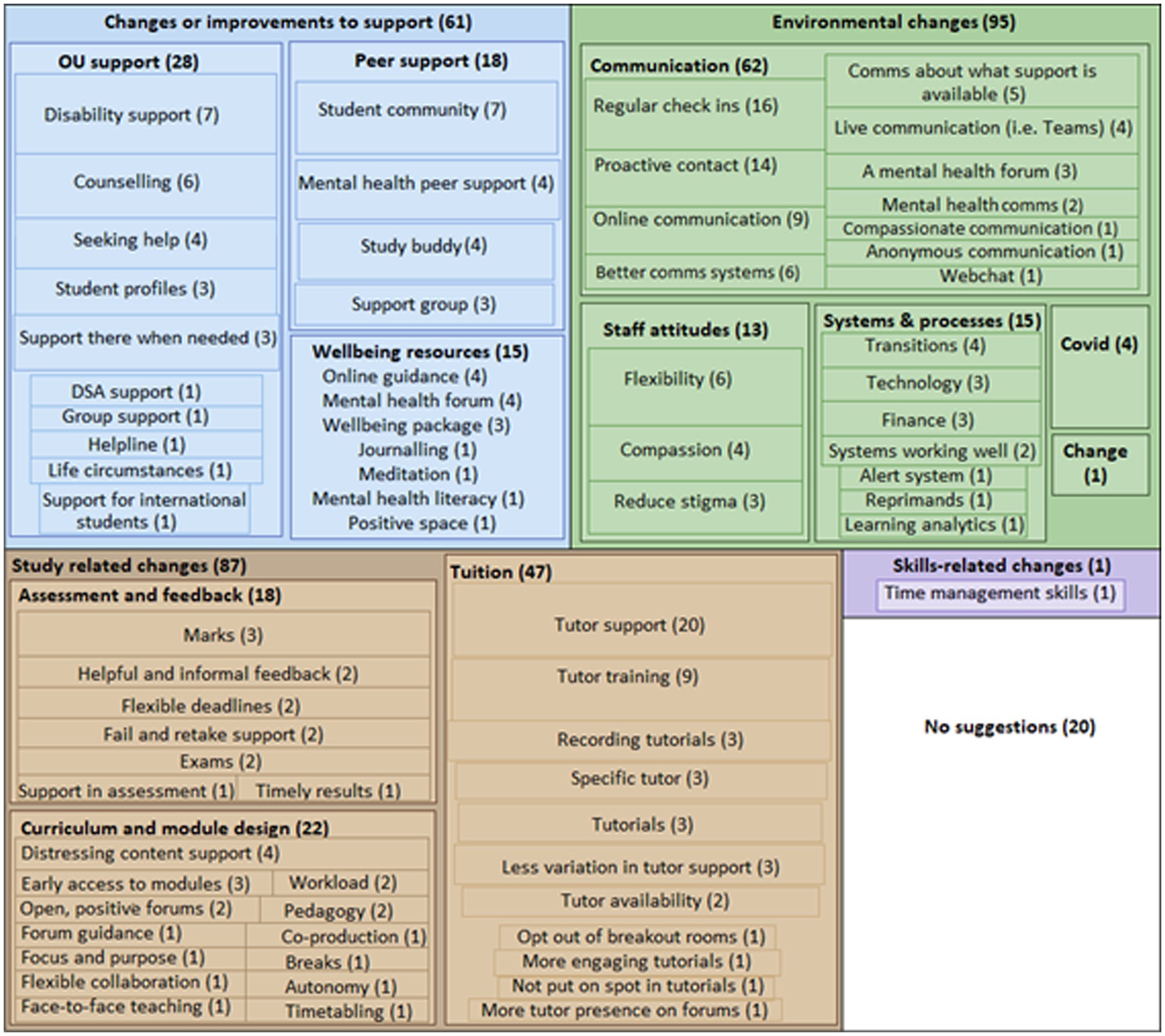
Figure 5. Suggestions for changes to university environments, study support and study practices to enhance student wellbeing.
‘Study-related changes’ contained sub-themes relating to assessment and feedback, curriculum, and tuition and tutor support. The most populated theme was ‘tuition’, with 47 coded references. These included suggestions to improve tutor support, such as:
‘Have a unified approach from tutors. In my last module I had a fantastic, supportive tutor but some of my peers had tutors who were very unhelpful and it caused them a lot of stress’
Suggestions for changes to curriculum (N = 22) included supporting students to manage distressing content, e.g.:
‘Offering trigger warning on potentially upsetting videos or resources.’
‘The occasional contact by the tutor, ideally by phone, to the student, may pre-empt difficulties and the opportunity to discuss topics that may have, unexpectedly, distressed the student.’
With regard to assessment and feedback (N = 18), students asked for changes to:
• Feedback (i.e., ‘More helpful feedback and more consistent feedback’)
• Flexible deadlines (i.e., ‘Be more flexible with final deadlines and EMAs’)
• Support for failing and retaking (i.e., ‘When I failed an exam I had no support or contact of any kind from tutor or the OU. Better support is needed if we fail an exam.’)
• Exams (i.e., ‘Consider making exams easier to manage for those with mental health issues’).
With regard to environmental changes, a key theme was ‘communication;’ with 62 coded references, this was the most populated theme. Suggestions included regular check ins (e.g., ‘Just check once in a while if students are coping or need more support’) and proactive contact (e.g., ‘Having people to reach out and actively engage with students who are clearly not engaging, not attending, are falling behind or performing poorly so ask them, non-judgementally and without threatening them with expulsion, whether there is any support that they need’).
Another theme under ‘environmental changes’ was systems and processes, with 15 coded references. Suggestions related to transition processes (e.g., ‘Not scaring students when they step up from level 1 to level 2 with a whole list of things which they are supposed to already know - which then later come up in the course. This made me very anxious.’); finance (e.g., ‘I would suggest that they should make more clarification on the Study finances that are available for students.’), and systems working well (e.g., ‘It would be helpful if the tutorial system had stayed the same I e being able to access any tutorials.’) Other themes under ‘environmental changes’ related to staff attitudes (N = 13), COVID-19 (N = 4) and general change (N = 1.)
There were 61 references to ‘changes or improvements to support’. Of these, 28 related to OU support (such as ‘Proactively seek out dyslexic students before their studies begin’); 18 related to peer support (i.e., ‘introduce study buddies to help feel less isolated and connections to others - to improve mental health not for learning/improving study outcomes’) and 15 related to mental health support (such as ‘I support having mental wellbeing resources that students can explore on the website if needed and tutors can refer students there if needed.’)
Finally, there was one ‘skills-related’ suggestion, relating to support developing time management skills.
‘More guidance on how to organise a study timetable for students with jobs that are not a standard 9am-5pm - i.e. how to balance it out but not overload oneself, and give examples of this. It took me years to learn this myself through trial and error, so more guidance would have helped (but the guidance is a lot better now than when I first started anyway).’
4.6. Prioritisation of areas for change
Students were asked how well, in general, they felt their wellbeing was currently supported in three overarching areas:
• OU environments, systems and people
• OU module curricula, assessment and learning activities
• Developing study skills, communication skills and other competencies through OU study
These questions aimed to identify the areas where students felt their wellbeing was less supported, in order to identify priority areas for future solutions. The results are shown in Figure 6.
Very few students felt badly supported. However, the area where students generally felt less well supported was OU module curricula, assessment and learning activities. This implies that action should be prioritised in this area.
5. Discussion
This study aimed to answer the following three research questions:
1. What barriers to mental wellbeing do distance learning students experience, and are particular demographic groups more likely to experience these barriers?
2. What enablers to mental wellbeing do distance learning students experience, and are particular demographic groups more likely to experience these enablers?
3. What changes do distance learning students recommend that would enhance mental wellbeing in distance learning?
5.1. Barriers and enablers experienced
The survey data supports the taxonomy model proposed by Lister et al. (2021), in which aspects of the higher education experience can be either barriers and enablers, depending on their design and how they are experienced by students. Students stated they experienced barriers and enablers to wellbeing in all the areas of Lister et al’s taxonomy, and aspects of the higher education experience can be either barriers and enablers, depending on their design and how they are experienced by students. The survey adds to this model by providing data on the numbers of students experiencing different barriers and enablers.
Assessment is clearly the most critical barrier for students disclosing mental health difficulties, with 71.90% stating this had been a barrier to their wellbeing. This is particularly significant when considered with the findings that students felt their wellbeing was least well supported in the area of module curricula, assessment and learning activities, and strongly implies that action should be prioritised in this area. The open comments show that assessment design, assessment type, deadlines and feedback can cause stress, anxiety, or contribute to barriers to wellbeing. This broadly supports the literature; many studies recognise that assessments are a trigger point for student stress and anxiety (i.e., Galante et al., 2018; Jones et al., 2018; Hill et al., 2019), and that there is a need for assessment practices in HE to evolve, to be more inclusive and less likely to provoke distress (Boud and Falchikov, 2007; Hanesworth et al., 2019). However, some participants found barrier themes to be enablers; some aspects of assessment were found to support or enable wellbeing. Open comments suggest that deadlines could be helpful, and pride in grades could have a positive impact on student wellbeing.
In contrast to assessment, it was interesting that university systems were not perceived to be a barrier or an enabler for many students, ranking second lowest in terms of barriers and lowest in terms of enablers. The few open comments related to particular problems experienced, or additional support received, suggesting that day-to-day systems may be unperceived by students, and not considered to be a barrier or enabler. This contrasts with the literature, where university systems are often seen to be a barrier (Tinklin et al., 2005; Markoulakis and Kirsh, 2013; Coughlan and Lister, 2018).
Overall, the survey revealed insights into the challenges of distance learning and the impacts on wellbeing. The open comments reveal that Covid-19 exacerbated the isolation and stress students felt as distance learners. However, students also reported positive impacts of distance learning as enablers to wellbeing, particularly around building their study skills, the people in students’ lives and their curriculum and module content. This aligns interestingly with the literature, which has found learning can have a positive impact on wellbeing, particularly with older adults (Field, 2009; Waller et al., 2018).
5.2. Demographic groups experiencing barriers and enablers
A clear theme emerging from the demographic analysis of data was that while barriers disproportionately affected students disclosing mental health difficulties (and to a lesser extent other disabilities), enablers were experienced more generally, with no significant difference between students with and without disability and mental health disclosures. This supports the contention often found in disability and inclusion literature that inclusive practice benefits all students, not just those with disabilities or particular study needs (Male, 1996; Rose and Meyer, 2002; Boyle, 2011; Fovet, 2018; Haynes, 2019; Lopez-Gavira et al., 2019).
The data implies that barriers in general were disproportionately experienced by minority or disadvantaged groups; in particular, students with a mental health condition, students with low socio-economic status, Black or ethnic minority students, and students with a disability other than mental health. Women and younger students were also disproportionately affected. The findings about women appear to support the general literature, as multiple survey studies have found women more likely to express difficulties with mental wellbeing in study (Bernhardsdóttir and Vilhjálmsson, 2013; Mokhtari et al., 2013; Evans et al., 2018). However, literature about mental health and age in higher education tends to position more mature students as more vulnerable to mental health difficulties (Wong and Kwok, 1997; Swain and Hammond, 2011; Busher and James, 2020), so the finding in this survey that younger students appear more vulnerable was interesting, particularly in the context of lifelong education. It may be that this is a particular feature of the distance learning environment; that distance learning is more challenging for younger students and that this can lead to barriers to wellbeing. It would be interesting to replicate this survey in a face-to-face learning institution, or in other lifelong education contexts, and identify if a similar pattern emerged.
5.3. Changes to enhance mental wellbeing in distance learning
This study also aimed to identify the changes distance learning students suggested to enhance mental wellbeing in distance learning. The most populated theme for suggestions for change related to communications, followed by tuition and tutor practice. This broadly supports the study by Baik et al., in which the highest number of student recommendations for change related to ‘Academic teachers and teaching practices,’ while changes to communication was the third most popular recommendation (Baik et al., 2019). However, ‘Assessment’ was of low priority in Baik et al’s study, the second-to-least populated, while it was the fourth most populated of twelve themes in this study.
Another interesting finding from the open question on suggested changes was the lack of focus on changes to students’ skills. There was only one suggestion to improve skills, compared to 87 suggestions for study-related changes, 95 suggestions for environmental changes and 61 suggestions for support-related changes. This contrasts sharply with the literature, much of which focuses on skills building as a way to build resilience and manage mental health (Hewitt and Stubbs, 2017; AMOSSHE, 2018; Barrable et al., 2018; Holdsworth et al., 2018). Referring back to the capabilities approach (Nussbaum, 2000), the skills-based solutions represent building internal capabilities, while the environmental, support and skills-related solutions suggest changes that facilitate external capabilities. It appears that the broader literature in the sector is more likely to perceive solutions require effort from the students in building internal skills and resilience. However, students appear to take the view that solutions should come from staff and the university in terms of changing practice, offering additional support and supporting external capabilities. It may be that both parties are to some extent shifting the burden of change to the other party. This concept should be explored further in a future study.
5.4. Limitations
There were limitations to this study. This study sought student voices, meaning the voices of Open University staff were missing, although staff voices were prioritised in an earlier phase of the overall study (Lister, 2021; Lister and McFarlane, 2021). Furthermore, low response numbers were received from certain demographic groups, such as Black or ethnic minority students, meaning their experiences are not adequately represented, their voices not sufficiently heard. Another limitation was (as with any survey) the participants were self-selecting, and this resulted in a volunteer bias where a larger number of students with mental health issues responded to the survey.
6. Conclusion
This paper has presented the findings from a survey sent to 5,000 students to identify barriers and enablers to wellbeing and ideas for change. This study challenges individualistic models of student wellbeing by identifying that assessment practices represent significant barriers to student mental health, and advances previous knowledge in this area by identifying enablers to wellbeing in building study skills, and in curriculum and module content. A clear message for educational providers, especially distance learning institutions, is that assessment strategies and practices should be prioritised as an area for action to better support student wellbeing in distance learning.
This study also revealed significant demographic differences in how students experience barriers and enablers and how likely they feel they are to benefit from solutions. Students with mental health difficulties were consistently more likely to experience barriers and more likely to feel they would benefit from solutions. Furthermore, enablers were more likely to be felt consistently by students, regardless of demographics. This sends a clear message to educational providers that prioritising enablers to student wellbeing in study environments and practices may be beneficial for all students, not only those with mental health difficulties or other particular study needs.
This study is one part of a larger project to identify changes that could be made to better support students’ mental wellbeing in distance learning environments, study and skills-building. More work is needed to identify solutions that can be embedded in practice, particularly in the area of assessment, to make distance education and lifelong learning more conducive to student mental wellbeing.
Data availability statement
The datasets presented in this article are not readily available because this data is confidential and as such is not openly shared. Anonymised data may be available upon request. Requests to access the datasets should be directed to klister@arden.ac.uk.
Ethics statement
The studies involving human participants were reviewed and approved by The Human Research Ethics Committee, Open University. The patients/participants provided their written informed consent to participate in this study.
Author contributions
All authors contributed to the survey instrument design and writing this paper. All authors contributed to the article and approved the submitted version.
Funding
This project was internally funded through the Open University Quality Enhancement and Innovation fund.
Acknowledgments
The authors would like to thank the students who took part in this study. Particular thanks are due to the students who took part in the pilot of the survey and generously contributed suggestions for changes to wording, style and structure.
Conflict of interest
The authors declare that the research was conducted in the absence of any commercial or financial relationships that could be construed as a potential conflict of interest.
Publisher’s note
All claims expressed in this article are solely those of the authors and do not necessarily represent those of their affiliated organizations, or those of the publisher, the editors and the reviewers. Any product that may be evaluated in this article, or claim that may be made by its manufacturer, is not guaranteed or endorsed by the publisher.
References
Advance, H. E. (2018). Equality +higher education: Students statistical report 2018. York, UK: Advance HE, 226.
AMOSSHE. (2018). Resilience toolkit. Available at: https://resiliencetoolkit.org.uk/ (Accessed: 14 August 2020).
Baik, C., Larcombe, W., and Brooker, A. (2019). How universities can enhance student mental wellbeing: the student perspective. High. Educ. Res. Dev. 38, 674–687. doi: 10.1080/07294360.2019.1576596
Barr, B. (2014). Identifying and addressing the mental health needs of online students in higher education. Online J. Distance Learn. Admin. 17.
Barrable, A., Papadatou-Pastou, M., and Tzotzoli, P. (2018). Supporting mental health, wellbeing and study skills in higher education: an online intervention system. Int. J. Ment. Heal. Syst. 12:54. doi: 10.1186/s13033-018-0233-z
BBC News. (2020). ‘Natasha Abrahart suicide: parents to sue university of Bristol’, BBC News, 20 July Available at: https://www.bbc.com/news/uk-england-nottinghamshire-53437940 (Accessed: 2 January 2021).
Bentley, M. (2017). Trigger warnings and the student experience. Politics 37, 470–485. doi: 10.1177/0263395716684526
Bernhardsdóttir, J., and Vilhjálmsson, R. (2013). Psychological distress among university female students and their need for mental health services. J. Psychiatr. Ment. Health Nurs. 20, 672–678. doi: 10.1111/jpm.12002
Boud, D., and Falchikov, N. (2007). Rethinking assessment in higher education: Learning for the longer term. London: Routledge.
Boyle, C. (2011). Facilitating the learning of all students: the “professional positive” of inclusive practice in Australian primary schools. Support Learn. 26, 72–78. doi: 10.1111/j.1467-9604.2011.01480.x
Braun, V., and Clarke, V. (2006). Using thematic analysis in psychology. Qual. Res. Psychol. 3, 77–101. doi: 10.1191/1478088706qp063oa
Brown, P. (2016). The invisible problem? Improving students’ mental health. Higher Educ. Policy Institute :66.
Busher, H., and James, N. (2020). Mature students’ socio-economic backgrounds and their choices of access to higher education courses. J. Furth. High. Educ. 44, 640–652. doi: 10.1080/0309877X.2019.1576857
Coughlan, T., and Lister, K. (2018). ‘The accessibility of administrative processes: assessing the impacts on students in higher education’, in Proceedings of the 15th international Cross-disciplinary conference on web accessibility (Web4All 2018). 15th international Cross-disciplinary conference on web accessibility (Web4All 2018), New York: ACM Press.
Coughlan, T., and Lister, K. (2022). “Creating stories of learning, for learning: exploring the potential of self-narrative in education with “our journey”” in Creativity and cognition (New York, NY, USA: Association for Computing Machinery), 526–531.
Coughlan, T., Lister, K., and Lucassen, M. (2021). Representing the unseen with “our journey”: a platform to capture affective experiences and support emotional awareness in university-level study. J. Formative Design Learn. 5, 39–52. doi: 10.1007/s41686-021-00055-9
Davies, S. C. (2013). Annual report of the chief medical officer 2013 public mental health priorities: Investing in the evidence. London: Department of Health, p. 320.
Evans, T. M., Bira, L., Gastelum, J. B., Weiss, L. T., and Vanderford, N. L. (2018). Evidence for a mental health crisis in graduate education. Nat. Biotechnol. 36, 282–284. doi: 10.1038/nbt.4089
Felton, A., and Stickley, T. (2004). Pedagogy, power and service user involvement. J. Psychiatr. Ment. Health Nurs. 11, 89–98. doi: 10.1111/j.1365-2850.2004.00693.x
Field, J. (2009). Good for your soul? Adult learning and mental well-being. Int. J. Lifelong Educ. 28, 175–191. doi: 10.1080/02601370902757034
Fovet, F. (2018). “Beyond accommodations. Using of universal design learning (UDL) as a lens when designing instruction and evaluation methods that do not exacerbate mental health issues,” in Pacific Rim International Conference on Disability and Diversity 2020 Conference Proceedings.
Galante, J., Dufour, G., Vainre, M., Wagner, A. P., Stochl, J., Benton, A., et al. (2018). A mindfulness-based intervention to increase resilience to stress in university students (the mindful student study): a pragmatic randomised controlled trial. Lancet Public Health 3, e72–e81. doi: 10.1016/S2468-2667(17)30231-1
Gilbert, T. (2016). Embedding and assessing compassion in the university curriculum. The International Academic Forum. Available at: http://uhra.herts.ac.uk/handle/2299/17435 (Accessed: 14 August 2020).
Hanesworth, P., Bracken, S., and Elkington, S. (2019). A typology for a social justice approach to assessment: learning from universal design and culturally sustaining pedagogy. Teach. High. Educ. 24, 98–114. doi: 10.1080/13562517.2018.1465405
Hartrey, L., Denieffe, S., and Wells, J. S. G. (2017). A systematic review of barriers and supports to the participation of students with mental health difficulties in higher education. Mental Health Prevention 6, 26–43. doi: 10.1016/j.mhp.2017.03.002
Haynes, A. (2019). ‘Reaching every student in the digital age: a showcase of UDL strategies in a large online course’, in. E-learn: World conference on E-learning in corporate, government, healthcare, and higher education, Association for the Advancement of computing in education (AACE), pp. 1287–1292. Available at: https://www.learntechlib.org/primary/p/211214/ (Accessed: 3 January 2020).
Heckman, J. J., and Corbin, C. O. (2016). ‘Capabilities and skills’, IZA Discussion papers, Institute for the Study of Labor, No. 10005, p. 32.
Heron, J., and Reason, P. (2016). A participatory inquiry paradigm. Qual. Inq. 3, 274–294. doi: 10.1177/107780049700300302
Hewitt, A., and Stubbs, M. (2017). Supporting law students’ skills development online--a strategy to improve skills and reduce student stress? Res. Learn. Technol. 25:24. doi: 10.25304/rlt.v25.1786
Hill, J., Healey, R. L., West, H., and Déry, C. (2019). Pedagogic partnership in higher education: encountering emotion in learning and enhancing student wellbeing. J. Geogr. High. Educ. 45, 167–185. doi: 10.1080/03098265.2019.1661366
Holdsworth, S., Turner, M., and Scott-Young, C. M. (2018). … not drowning, waving. Resilience and university: a student perspective. Stud. High. Educ. 43, 1837–1853. doi: 10.1080/03075079.2017.1284193
Houghton, A.-M., and Anderson, J. (2017). Embedding mental wellbeing in the curriculum: Maximising success in higher education. York: Higher Education Academy, p. 44.
Houston, J. B., First, J., Spialek, M. L., Sorenson, M. E., Mills-Sandoval, T., Lockett, M. K., et al. (2017). Randomized controlled trial of the resilience and coping intervention (RCI) with undergraduate university students. J. Am. Coll. Heal. 65, 1–9. doi: 10.1080/07448481.2016.1227826
Johanson, G. A., and Brooks, G. P. (2010). Initial scale development: sample size for pilot studies. Educ. Psychol. Meas. 70, 394–400. doi: 10.1177/0013164409355692
Jones, P. J., Park, S. Y., and Lefevor, G. T. (2018). Contemporary college student anxiety: the role of academic distress, financial stress, and support. J. Coll. Couns. 21, 252–264. doi: 10.1002/jocc.12107
Jones, E., Priestley, M., Brewster, L., Wilbraham, S. J., Hughes, G., and Spanner, L. (2020). Student wellbeing and assessment in higher education: the balancing act. Assess. Eval. High. Educ. 46, 438–450. doi: 10.1080/02602938.2020.1782344
Larcombe, W., Finch, S., Sore, R., Murray, C. M., Kentish, S., Mulder, R. A., et al. (2016). Prevalence and socio-demographic correlates of psychological distress among students at an Australian university. Stud. High. Educ. 41, 1074–1091. doi: 10.1080/03075079.2014.966072
Lee, E., and Kim, Y. (2019). Effect of university students’ sedentary behavior on stress, anxiety, and depression. Perspect. Psychiatr. Care 55, 164–169. doi: 10.1111/ppc.12296
Lipson, S. K., Lattie, E. G., and Eisenberg, D. (2018). Increased rates of mental health service utilization by U.S. college students: 10-year population-level trends (2007–2017). Psychiatr. Serv. 70, 60–63. doi: 10.1176/appi.ps.201800332
Lister, K. (2021). Barriers and enablers to mental wellbeing in distance learning: staff and student perspectives. European J. Open, Distance and E-Learning [Preprint]
Lister, K. (2022). Participatory digital approaches to embedding student wellbeing in higher education. Front. Educ. 7. doi: 10.3389/feduc.2022.924868
Lister, K., and McFarlane, R. (2021). Designing for wellbeing: an inclusive learning design approach with student mental health vignettes. Open Praxis 13:184. doi: 10.5944/openpraxis.13.2.126
Lister, K., Seale, J., and Douce, C. (2021). Mental health in distance learning: a taxonomy of barriers and enablers to student mental wellbeing. Open Learning: J. Open, Distance and e-learning 36. doi: 10.1080/02680513.2021.1899907
Lopez-Gavira, R., Moriña, A., and Morgado, B. (2019). Challenges to inclusive education at the university: the perspective of students and disability support service staff. Innovation: European J. Social Science Res. 34, 292–304. doi: 10.1080/13511610.2019.1578198
Male, M. (1996). Technology for Inclusion: Meeting the special needs of all students, undefined. Available at: /paper/Technology-for-Inclusion%3A-Meeting-the-Special-Needs-Male/8c80660798434c7a519d087a3de6e31aeebde476 (Accessed: 29 December 2020).
Markoulakis, R., and Kirsh, B. (2013). Difficulties for university students with mental health problems: a critical interpretive synthesis. Rev. High. Educ. 37, 77–100. doi: 10.1353/rhe.2013.0073
McAllister, M., Knight, B. A., Hasking, P., Withyman, C., and Dawkins, J. (2018). Building resilience in regional youth: impacts of a universal mental health promotion programme. Int. J. Ment. Health Nurs. 27, 1044–1054. doi: 10.1111/inm.12412
McPherson, E., Collins, T., and Gallen, A.-M. (2019). ‘Enabling inclusive group work’, in Proceedings of the 12th annual international conference of education, research and innovation (ICERI 2019). Proceedings of the 12th annual international conference of education, research and innovation (ICERI 2019), Seville, Spain: IATED, Available at: http://oro.open.ac.uk/68480/ (Accessed: 4 August 2020).
Mertens, D. M. (2007). Transformative paradigm: mixed methods and social justice. J. Mixed Methods Res. 1, 212–225. doi: 10.1177/1558689807302811
Mokhtari, M., Dehghan, S. F., Asghari, M., Ghasembaklo, U., Mohamadyari, G., Azadmanesh, S. A., et al. (2013). Epidemiology of mental health problems in female students: a questionnaire survey. J. Epidemiology and Global Health 3, 83–88. doi: 10.1016/j.jegh.2013.02.005
Murugesu, J. (2019). Academics need greater help in addressing the mental health problems of their students. Times Higher Educ. (THE).
Neves, J., and Hillman, N. (2019). Student Academic Experience Survey 2019. Higher Educ. Policy Institute and Advance HE.
Nussbaum, M. C. (2000). Women and human development: The capabilities approach. Cambridge: Cambridge University Press (The Seeley Lectures).
Office for Students (2019). Office for Students Insight Brief Mental Health. Bristol, UK: Office for Students.
Office of National Statistics. (2020). Coronavirus and higher education students - Office for National Statistics. Office of National Statistics. Available at: https://www.ons.gov.uk/peoplepopulationandcommunity/healthandsocialcare/healthandwellbeing/bulletins/coronavirusandhighereducationstudents/england20novemberto25november2020 (Accessed: 2 January 2021).
Piper, R., and Emmanuel, T. (2019). Co-producing mental health strategies with students: A guide for the higher education sector. Leeds: Student Minds, p. 99.
Ribeiro, Í. J. S., Pereira, R., Freire, I. V., de Oliveira, B. G., Casotti, C. A., and Boery, E. N. (2018). Stress and quality of life among university students: a systematic literature review. Health Professions Educ. 4, 70–77. doi: 10.1016/j.hpe.2017.03.002
Richardson, J. T. E. (2015). Academic attainment in students with mental health difficulties in distance education. Int. J. Ment. Health 44, 231–240. doi: 10.1080/00207411.2015.1035084
Robeyns, I. (2005). The capability approach: a theoretical survey. J. Hum. Dev. 6, 93–117. doi: 10.1080/146498805200034266
Rose, D. H., and Meyer, A. (2002). Teaching every student in the digital age: universal Design for Learning. Asso. Supervision Curriculum Develop. 1703 N.
Slavin, S. J., Schindler, D. L., and Chibnall, J. T. (2014). Medical student mental health 3.0: improving student wellness through curricular changes. Acad. Med. 89, 573–577. doi: 10.1097/ACM.0000000000000166
Stallman, H. M. (2010). Psychological distress in university students: a comparison with general population data. Aust. Psychol. 45, 249–257. doi: 10.1080/00050067.2010.482109
Swain, J., and Hammond, C. (2011). The motivations and outcomes of studying for part-time mature students in higher education. Int. J. Lifelong Educ. 30, 591–612. doi: 10.1080/02601370.2011.579736
The Open University. (2019). The Open University access and participation plan 2019/20. England: The Open University, p. 30.
Tinklin, T., Riddell, S., and Wilson, A. (2005). Support for students with mental health difficulties in higher education: the students’ perspective. Br. J. Guid. Couns. 33, 495–512. doi: 10.1080/03069880500327496
Viskovich, S., and Pakenham, K. I. (2018). Pilot evaluation of a web-based acceptance and commitment therapy program to promote mental health skills in university students. J. Clin. Psychol. 74, 2047–2069. doi: 10.1002/jclp.22656
Waller, R., Hodge, S., Holford, J., Milana, M., and Webb, S. (2018). Adult education, mental health and mental wellbeing. Int. J. Lifelong Educ. 37, 397–400. doi: 10.1080/02601370.2019.1533064
Weale, S. (2020). ‘More than half of students polled report mental health slump’, The Guardian, 9 December. Available at: https://www.theguardian.com/education/2020/dec/09/more-than-half-of-students-polled-report-mental-health-slump (Accessed: 2 January 2021).
Weller, M., van Ameijde, J., and Cross, S. (2018). Learning Design for Student Retention. J. Perspect. Applied Acad. Prac. 6. doi: 10.14297/jpaap.v6i2.318
Whittle, R., Brewster, L., Medd, W., Simmons, H., Young, R., and Graham, E. (2020). The “present-tense” experience of failure in the university: reflections from an action research project. Emot. Space Soc. 37:100719. doi: 10.1016/j.emospa.2020.100719
Winzer, R., Lindberg, L., Guldbrandsson, K., and Sidorchuk, A. (2018). Effects of mental health interventions for students in higher education are sustainable over time: a systematic review and meta-analysis of randomized controlled trials. Peer J 6:e4598. doi: 10.7717/peerj.4598
Keywords: mental health, mental wellbeing, students, compassion, participatory, social model
Citation: Lister K, Andrews K, Buxton J, Douce C and Seale J (2023) Assessment, life circumstances, curriculum and skills: Barriers and enablers to student mental wellbeing in distance learning. Front. Psychol. 14:1076985. doi: 10.3389/fpsyg.2023.1076985
Edited by:
Kathryn Waddington, University of Westminster, United KingdomReviewed by:
Muhammad Ashraf, Government Degree College Karachi, PakistanMuhammad Zulqarnain Arshad, Universiti Utara Malaysia, Malaysia
Copyright © 2023 Lister, Andrews, Buxton, Douce and Seale. This is an open-access article distributed under the terms of the Creative Commons Attribution License (CC BY). The use, distribution or reproduction in other forums is permitted, provided the original author(s) and the copyright owner(s) are credited and that the original publication in this journal is cited, in accordance with accepted academic practice. No use, distribution or reproduction is permitted which does not comply with these terms.
*Correspondence: Kate Lister, ✉ klister@arden.ac.uk
 Kate Lister
Kate Lister Kyle Andrews2
Kyle Andrews2